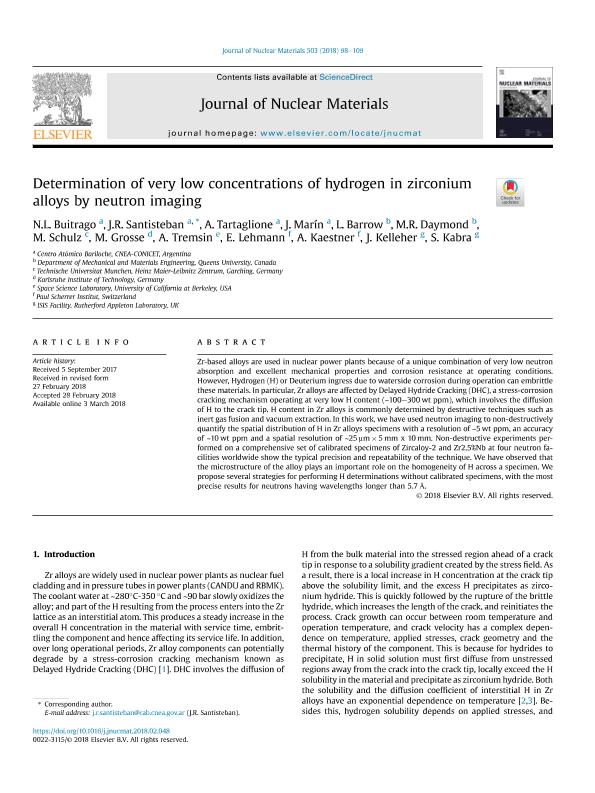Mostrar el registro sencillo del ítem
dc.contributor.author
Buitrago Montañez, Nayibe Lucia

dc.contributor.author
Santisteban, Javier Roberto

dc.contributor.author
Tartaglione, Aureliano

dc.contributor.author
Marín, J.
dc.contributor.author
Barrow, L.
dc.contributor.author
Daymond, M. R.
dc.contributor.author
Schulz, M.
dc.contributor.author
Grosse, M.
dc.contributor.author
Tremsin, A.
dc.contributor.author
Lehmann, E.
dc.contributor.author
Kaestner, A.
dc.contributor.author
Kelleher, J.
dc.contributor.author
Kabra, S.
dc.date.available
2020-04-06T20:51:33Z
dc.date.issued
2018-05
dc.identifier.citation
Buitrago Montañez, Nayibe Lucia; Santisteban, Javier Roberto; Tartaglione, Aureliano; Marín, J.; Barrow, L.; et al.; Determination of very low concentrations of hydrogen in zirconium alloys by neutron imaging; Elsevier Science; Journal of Nuclear Materials; 503; 5-2018; 98-109
dc.identifier.issn
0022-3115
dc.identifier.uri
http://hdl.handle.net/11336/102109
dc.description.abstract
Zr-based alloys are used in nuclear power plants because of a unique combination of very low neutron absorption and excellent mechanical properties and corrosion resistance at operating conditions. However, Hydrogen (H) or Deuterium ingress due to waterside corrosion during operation can embrittle these materials. In particular, Zr alloys are affected by Delayed Hydride Cracking (DHC), a stress-corrosion cracking mechanism operating at very low H content (∼100?300 wt ppm), which involves the diffusion of H to the crack tip. H content in Zr alloys is commonly determined by destructive techniques such as inert gas fusion and vacuum extraction. In this work, we have used neutron imaging to non-destructively quantify the spatial distribution of H in Zr alloys specimens with a resolution of ∼5 wt ppm, an accuracy of ∼10 wt ppm and a spatial resolution of ∼25 μm × 5 mm x 10 mm. Non-destructive experiments performed on a comprehensive set of calibrated specimens of Zircaloy-2 and Zr2.5%Nb at four neutron facilities worldwide show the typical precision and repeatability of the technique. We have observed that the microstructure of the alloy plays an important role on the homogeneity of H across a specimen. We propose several strategies for performing H determinations without calibrated specimens, with the most precise results for neutrons having wavelengths longer than 5.7 Å.
dc.format
application/pdf
dc.language.iso
eng
dc.publisher
Elsevier Science

dc.rights
info:eu-repo/semantics/openAccess
dc.rights.uri
https://creativecommons.org/licenses/by-nc-sa/2.5/ar/
dc.subject
HYDROGEN FAILURE
dc.subject
ZIRCONIUM ALLOYS
dc.subject
NEUTRON TRANSMISSION
dc.subject
PRESSURE TUBES
dc.subject.classification
Física de los Materiales Condensados

dc.subject.classification
Ciencias Físicas

dc.subject.classification
CIENCIAS NATURALES Y EXACTAS

dc.title
Determination of very low concentrations of hydrogen in zirconium alloys by neutron imaging
dc.type
info:eu-repo/semantics/article
dc.type
info:ar-repo/semantics/artículo
dc.type
info:eu-repo/semantics/publishedVersion
dc.date.updated
2019-10-15T17:55:55Z
dc.journal.volume
503
dc.journal.pagination
98-109
dc.journal.pais
Países Bajos

dc.description.fil
Fil: Buitrago Montañez, Nayibe Lucia. Comisión Nacional de Energía Atómica. Centro Atómico Bariloche; Argentina. Consejo Nacional de Investigaciones Científicas y Técnicas; Argentina
dc.description.fil
Fil: Santisteban, Javier Roberto. Consejo Nacional de Investigaciones Científicas y Técnicas; Argentina. Comisión Nacional de Energía Atómica. Centro Atómico Bariloche; Argentina
dc.description.fil
Fil: Tartaglione, Aureliano. Consejo Nacional de Investigaciones Científicas y Técnicas; Argentina. Comisión Nacional de Energía Atómica. Centro Atómico Bariloche; Argentina
dc.description.fil
Fil: Marín, J.. Comisión Nacional de Energía Atómica. Centro Atómico Bariloche; Argentina
dc.description.fil
Fil: Barrow, L.. Queens University; Canadá
dc.description.fil
Fil: Daymond, M. R.. Queens University; Canadá
dc.description.fil
Fil: Schulz, M.. Universitat Technical Zu Munich; Alemania
dc.description.fil
Fil: Grosse, M.. Karlsruher Institut fur Technologie; Alemania
dc.description.fil
Fil: Tremsin, A.. University of California at Berkeley; Estados Unidos
dc.description.fil
Fil: Lehmann, E.. Paul Scherrer Institut; Suiza
dc.description.fil
Fil: Kaestner, A.. Paul Scherrer Institut; Suiza
dc.description.fil
Fil: Kelleher, J.. Rutherford Appleton Laboratory; Reino Unido
dc.description.fil
Fil: Kabra, S.. Rutherford Appleton Laboratory; Reino Unido
dc.journal.title
Journal of Nuclear Materials

dc.relation.alternativeid
info:eu-repo/semantics/altIdentifier/doi/http://dx.doi.org/10.1016/j.jnucmat.2018.02.048
dc.relation.alternativeid
info:eu-repo/semantics/altIdentifier/url/https://www.sciencedirect.com/science/article/pii/S0022311517312461
Archivos asociados
